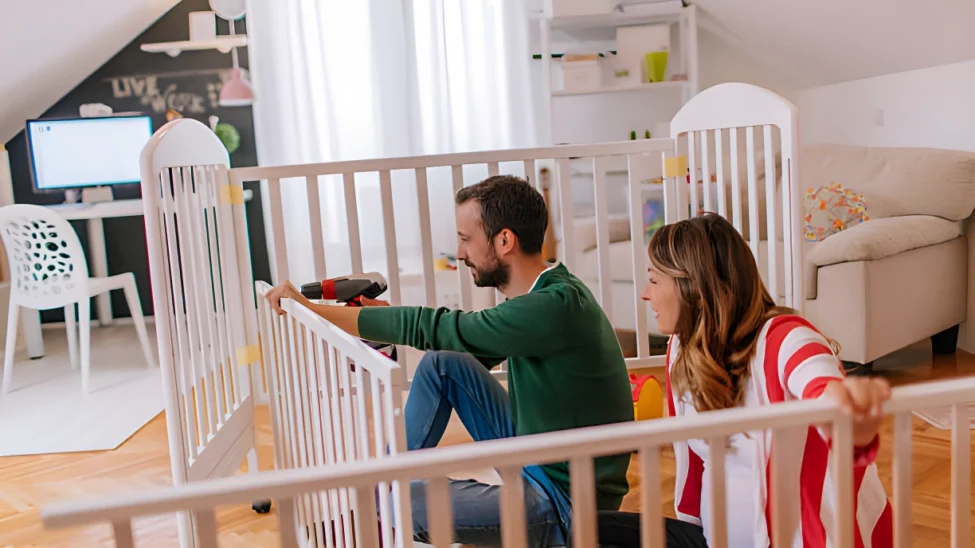
It’s Not Just a Squeak — It’s a Signal
Let’s be honest — we rarely give the crib a second thought after it’s assembled. Once it’s up and looks pretty, we check the box and move on. But here’s what I’ve learned both as a sleep consultant and as a mom who once caught her son pulling on a crib rail that moved just a little too much: a stable crib is foundational to safe sleep. It’s not extra. It’s essential.
Crib instability isn’t always dramatic. Sometimes it starts small — a wobble when you lean on the side, a faint squeak when the baby shifts, a bolt that loosens over time. But those little red flags can point to bigger issues. The risk of a crib collapsing or warping isn’t common, but it’s real, especially with older furniture or frequent disassembly.
Even a small instability can create just enough movement to cause gaps between the mattress and the frame — a real suffocation hazard for younger babies.
I once visited a family whose baby had started waking every hour. They thought it was a sleep regression. Turned out, every time the baby turned, the loose frame would creak — waking him up. The fix was a wrench and five minutes. Sleep was restored. Sometimes it’s that simple.
So What Actually Makes a Crib Stable?
It’s not just about tight screws. Real stability comes from three things: the quality of the materials, how the joints are constructed, and the overall design. Not all cribs are created equal — and price doesn’t always predict sturdiness.
Solid wood cribs tend to outperform lightweight engineered wood or MDF in long-term stability, especially if the crib is going to be moved or converted. Pay attention to how the legs are joined to the frame. A strong metal bracket system is usually more reliable than wooden pegs and glue, especially with repeated use.
If your crib converts to a toddler bed or daybed, check how the conversion kit attaches. Some systems compromise structural integrity after conversion. It might look fine but lose its strength after multiple transformations.
A high-end crib can still wobble if it’s not put together with care. The opposite is also true — a budget crib, correctly assembled and maintained, can be rock solid.
And don’t ignore design. Sleek minimalist frames might be pretty, but if the base doesn’t distribute weight evenly or if the legs are too narrow, they’re more prone to shifting, especially on soft carpets or uneven floors.
When the Frame Talks Back: Warning Signs to Watch
Most of us catch instability by accident. Maybe you sit on the edge, or your toddler leans over the side and the whole thing shifts. But it helps to know what to watch for intentionally. A quick visual and physical check once a week can prevent headaches — and heartaches — down the road.
- The crib moves or rocks when pushed gently from the side
- Bolts or screws feel loose or fall out easily
- You hear creaking, clicking, or cracking sounds during use
- The mattress shifts inside the frame or doesn’t sit flush
- Visible gaps appear between slats or where parts join
With one client, the mattress seemed to slope slightly to the right. It turned out the base board had warped from humidity and wasn’t sitting evenly anymore. Not dangerous yet — but left unattended, it could’ve broken under pressure. We swapped it out before it became a problem.
If something feels “off,” trust that instinct. Cribs shouldn’t move — at all. Not a sway, not a shift. Rocking chairs should rock. Cribs shouldn’t.
Maintenance That’s Quicker Than Making Coffee
You don’t need to treat your crib like a piece of machinery. But a simple once-a-week ritual can help. I do mine while tidying the nursery on Sundays. It takes maybe two minutes, and now it’s just muscle memory.
What to check:
- Run your hand along the joints and corners — feel for movement or looseness
- Wiggle the frame gently from different sides
- Check under the mattress for frame alignment and board integrity
- Listen for any new noises
If you find something, don’t wait. A screwdriver or Allen key solves 90% of the problems right away. For anything structural — like a crack in the wood or a split frame — stop using it until you’ve replaced or repaired the piece. No nap is worth the risk.
When It’s Time to Retire the Crib
We get sentimental about furniture. I’ve seen families hang on to their baby’s first crib long after it’s safe. I get it. But safety comes first — always. A crib that’s seen multiple kids, repeated assemblies, or even a storage stint in a damp garage might not be trustworthy anymore.
Signs it’s time to let go:
- Wood is splintering, cracked, or warped
- The frame is visibly uneven or won’t tighten fully
- Multiple parts have been replaced or improvised
- It no longer meets current safety standards (check labels!)
One mom I worked with had a beautiful vintage crib from her own childhood. We realized the slat gaps were too wide, and the drop-side was no longer considered safe. It was a hard goodbye, but we turned it into a toy shelf — safe, meaningful, and still in the room.
If the crib gives you stress instead of support, it’s time. A new one costs less than a hospital bill or a sleepless night.


